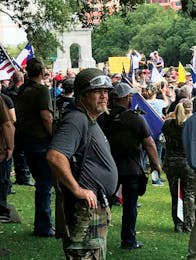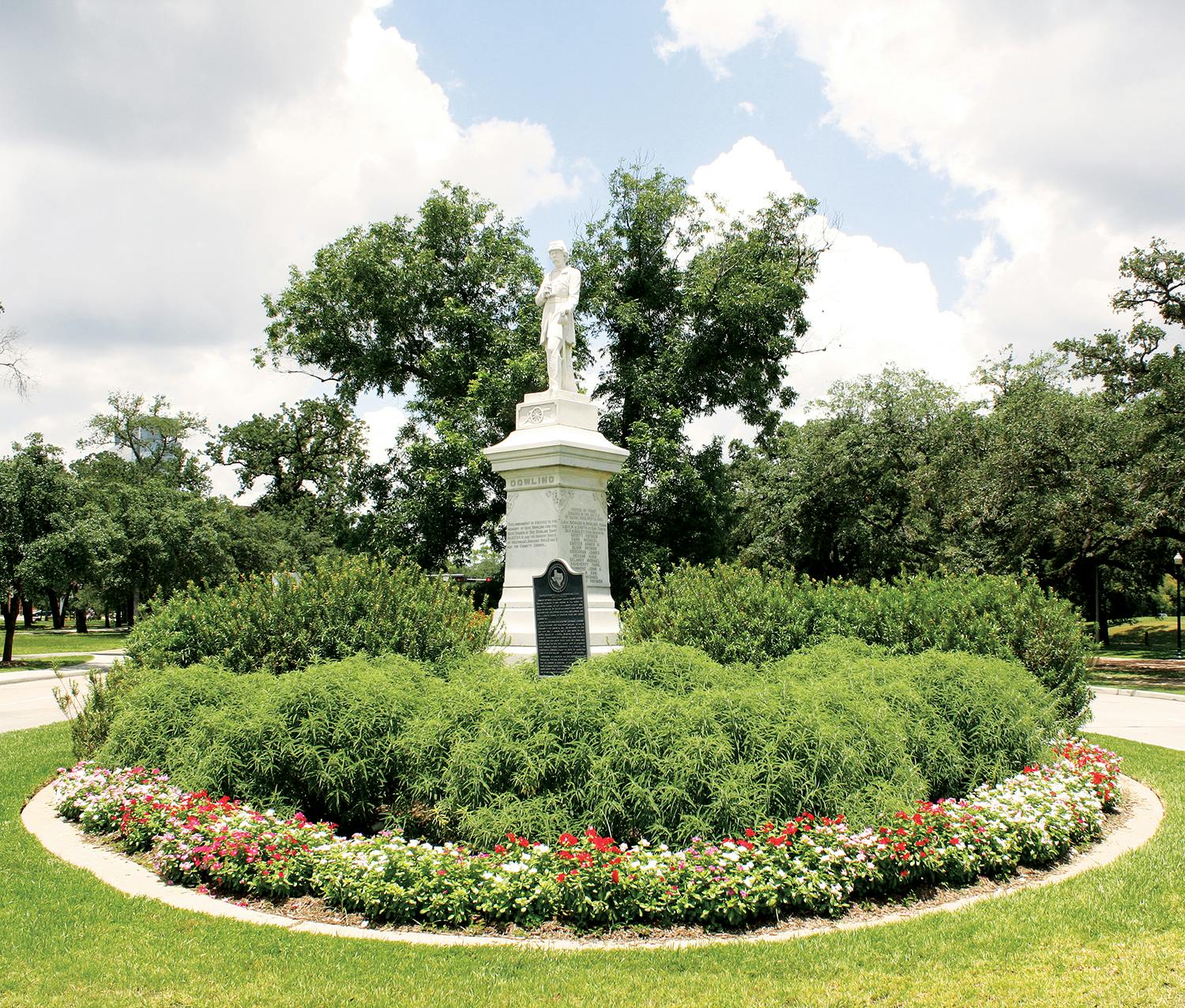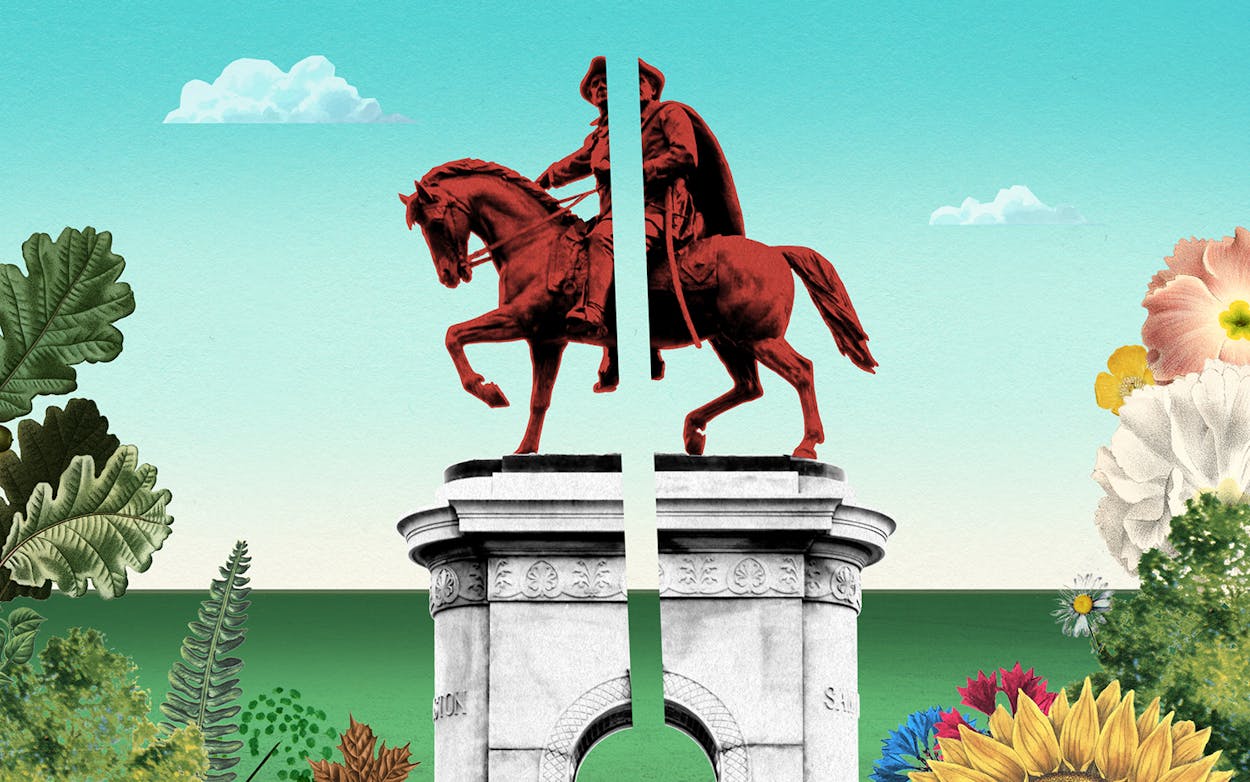On the north side of Hermann Park, a 445-acre urban green space in the heart of Houston’s Museum District, a massive monument stands to honor the city’s namesake. The statue, a bronze depiction of Sam Houston in military garb atop his horse, pointing east toward the San Jacinto battlefield, sits on a colossal granite arch. The monument, nearly fifty feet tall, is one of the city’s most iconic pieces of art and history and has stood over the park’s entrance since 1925. And, in May, a plan was launched to destroy it.
The threat started with a Facebook post on May 18 from a group calling itself Texas Antifa. “We’re about to have a huge event in Houston,” the post read. “The Fascists better not show up with violence or they will be limping home bruised, broken, hurt, and crying with their tails tucked between their legs.” A follow-up post on May 22 featured a picture of the Sam Houston monument covered in text: “This statue’s demise begins on June 10.” An accompanying message read, “Comrades, we need to fight to remove the disgusting statues of ALL war criminals and slave owners. Texans want these statues removed!” Yet another post promised that after the Hermann Park monument was dealt with, the towering Sam Houston statue on Interstate 45 in Huntsville would be pulverized to gravel and Houston’s namesake national forest would be renamed.
The Houston Chronicle published a story about Texas Antifa’s plans, and local television station KPRC ran a similar report on its five o’clock broadcast, complete with a live shot from the statue, man-on-the-street interviews, and a comment from Houston’s mayor. “Antifa,” a name long used to define various far-left activist groups across the country pushing for “anti-fascist action,” had become a bit of phenomenon in recent months, thanks to their violent clashes with police and counterprotesters. Now, it seemed, Antifa had brought the fight to Houston.

But it remained unclear what, exactly, Texas Antifa planned to do. How many people would show up? Would they really vandalize the Houston statue? Could they destroy it? Would they come for a fight? When KPRC contacted the group for clarification, a member responded, “We don’t speak with the fascist media.”
News of the group’s plans spread across right-wing blogs and message boards, and a story posted on Glenn Beck’s site went so far as to proclaim that “radicals in Texas have declared war.” On May 31, Houston activist Quanell X appeared on the local Fox affiliate’s morning show to declare his support for Texas Antifa. “They’re absolutely right; pull that racist Sam Houston down,” he said. “We’ll all pull him down.”
The interview seemed to be a tipping point. In the days that followed, an official counterprotest group, This Is Texas, emerged and posted a call to arms. It read, “Antifa has come out saying they will be bringing several large (communist) groups together to host a rally. . . . This list includes Black Panther Party, Antifa & more. Their goal is to remove the Sam Houston statue. . . . We invite anyone who loves Texas and wants to protect our sovereign soil and history to join us. Open carry is welcomed and encouraged as well as any armor or ballistics vests. . . . Bring your flags and fly them high!”
On June 10, the patriots came, several hundred by early morning, and gathered behind the statue, on the west side of the park’s reflection pool. They were a motley assortment, some in camouflage army attire, others wearing vests from obscure motorcycle clubs, many of them armed with pistols and AR-15s. There was plenty of flag-waving; “Don’t Tread on Me” and “Come and Take It” were common messages. Placards abounded, bearing slogans like “Red Scum Your Days Are Done” and “CNN=ISIS.”
It didn’t take long for dissension to sweep through the ranks. Organizers, who had told the media ahead of time that racists weren’t welcome, got into a confrontation with a group of men and women waving Confederate flags. A tattooed man who belonged to the Oath Keepers—an anti-government organization made up of veterans, active-duty military, and first responders—put a chokehold on a young man whose placards bore Pepe the Frog images, anti-Israel sentiments, and crypto-Nazi insignia. “What about the memes?” the young man pleaded, just before he was grabbed. “These are good memes!” He was turned loose after a few seconds and escorted from the protest to taunts of “Get that Nazi out of here!”
Yet there was one group that hadn’t shown up: Texas Antifa. Dozens of police, some on foot, others on horseback, were standing in wait, and a mass casualty unit was parked nearby. A Houston Police Department helicopter circled overhead, filling the park with an incessant mosquito-like whine. As the protesters waited for Antifa and girded themselves for battle in the park, many of them wondered: Where was the enemy?

In the months before Texas Antifa’s announcement, political violence across the country had become very real, and much of it involved Antifa groups. In February, for example, at the University of California, Berkeley, Antifa groups clashed with police on campus while protesting a scheduled appearance of alt-right provocateur Milo Yiannopoulos. Between the Molotov cocktails and smashed windows, the protests resulted in close to $500,000 in damage.
A month later, when Antifa came back to the city to protest a “March 4 Trump” rally at a park near campus, a large contingent of counterprotesters was waiting. In the fight that ensued, ten people were arrested, including four for assault with a deadly weapon. The following month, the two sides clashed again near campus, and despite a heavy police presence, seven people were taken to the hospital for injuries, and both sides blamed the other for instigating the fights.
At the same time, in New Orleans, a battle over the removal of Confederate statues from public property was taking place. In April, as the city prepared to dismantle four monuments that honored once-beloved Confederates, everyone from the mayor to the heavy-equipment operators who would be doing the work began receiving threats over the removal of the statues. Contractors, wearing bulletproof vests and working under the protection of police snipers and barricades, took down the first monument in the early morning hours of April 24. A couple of weeks later, right-wing bloggers circulated unconfirmed reports of an Antifa group driving through the city in an armored vehicle and vandalizing statues. When a picture of a defaced statue popped up on social media, the New Orleans Antifa group tweeted: “We applaud the ‘vandals’ who improved the P.G.T. Beauregard monument near City Park.” All of which made the Houston situation ripe for confrontation.
But the choice of the Sam Houston statue as a target was odd from the start, for one simple reason: Houston was an ardent foe of the Confederacy. In 1927, Dallas journalist Sam H. Acheson penned a magazine article about the unveiling of the statue. Acheson wondered, “Why did it take the city of Houston almost one hundred years to erect a monument to its founder?” The answer was clear: the old Houstonian elite regarded the hero of San Jacinto as a traitor, because he chose the Union over the Confederacy. “[And] for that he has never been forgiven,” Acheson wrote.
Which isn’t to say Sam Houston wore a white hat; though he was an opponent of the Confederacy, he was also a slaveholder. Nationwide, however, Antifa groups that have called for removing statues have focused their ire not on slaveholders but on men who fought for the Confederacy. And in that regard, the city of Houston is a target-rich environment. There are at least two public monuments in Houston honoring the Lost Cause: The Spirit of the Confederacy, a twelve-foot bronze of a defiant-looking angel that stands in Sam Houston Park on the west side of downtown and, on the south side of Hermann Park, a statue of Dick Dowling, the Confederate cannoneer who staved off a Union amphibious invasion of Texas. And then there’s Hermann Park itself, which was named after George Hermann, a Confederate cavalryman. But Texas Antifa had ignored all of those obvious targets and gone after Sam Houston. Why?
As the sun set on the rally that day, the answer was revealed when Texas Antifa posted a new message. “This was a fake Antifa [event],” it read. “It was never intended to attract Antifa or other groups, but, rather, to dissuade them from showing. It was intended to bring many Texans together to hopefully create a more cohesive defense against such groups.”

Texas Antifa, in short, doesn’t really exist. The entire thing was apparently a right-wing hoax—though who, exactly, was behind it remains a mystery. The people who created the so-called Texas Antifa claimed that by unifying Texas “patriots,” they could pressure Texas legislators to pass a law protecting public monuments from removal, so that what happened in New Orleans wouldn’t happen here. “We said there would be several groups there, and there were,” the post explained. “They were not groups on the Left, but on the Right. The largest Texas Patriot Rally in a very long time was accomplished. This is in your hands now.”
It didn’t take long for some of the counterprotesters to decry the ruse. A few of them had driven in from hundreds of miles away and felt cheated at not getting a confrontation. Some wondered if Texas Antifa and This Is Texas (which has since changed its name to This Is Texas Freedom Force) were working together: one creating the threat, the other offering a solution.
“You lied, in other words,” one counter-protester posted on the Texas Antifa page in the aftermath. “I am a forgiving man, but I do remember. Next time you guys cry ‘Wolf,’ If it isn’t within 2 hours of my house, I’m gonna have a hard time convincing myself to go. Now I have to look my wife in the eye and explain to her that my trip to Houston was because someone lied. I have to explain to her that the $250 in expenses and 10 hours of driving was for nothing.”
Houston is home to a real Antifa group, which had encouraged its members not to attend the rally because they believed it was fake. In the aftermath, the Houston Antifa pointed to Texas Antifa as evidence of a nationwide drive to whip up anger on the far right.
Still, many others said that the protest was worth it, even though it was nothing but a giant troll job. “Color me impressed,” one man posted. “You guys stirred a lot of emotions in we Texans with this campaign. We rallied in impressive numbers, all standing ready to fight to defend our history. It was amazing.”
What would Sam Houston have thought? Texas historian and Houston biographer James L. Haley believes he might have admired the prank, if not the sentiments behind it. “Nobody appreciated a good practical joke more than Sam Houston,” Haley says. “But he could also spot phonies a mile away. For these goons to hoot and brandish their guns and Confederate flags in his name and for his legacy, that would have mortified him.”
- More About:
- Politics & Policy
- Houston








